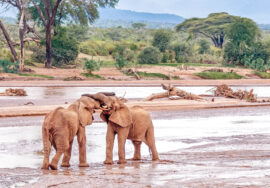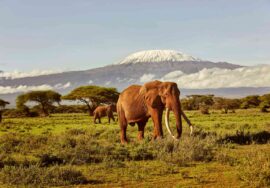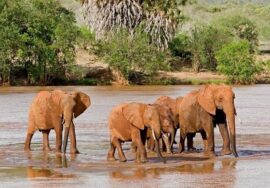
Nairobi National Park
Nairobi National Park
Location
Nairobi National Park is located south of Nairobi, a 4.5-mile drive from the Capital’s CBD along the A104 road. The park is situated around 5,500 feet above sea level and comprises open savanna, wooded regions, and river valleys.
Size
The size of Nairobi National Park is approximately 45 square miles.
History
Gazetted as a National Park in 1946, Nairobi National Park is one of the few national parks located so close to a capital city. In 1963, the Nairobi Animal Orphanage was established in the park and serves as a rehabilitation centre for various wild animals. A key attraction in the park is the site of the Ivory Burning Monument, erected to commemorate the burning of 12 tonnes of ivory in 1989 by then President Daniel Arap Moi.
Entrance Fees & Permits
Entrance fees during low, shoulder, and peak seasons are USD 43 per adult per day and USD 20 per child per day for visitors under 12 years old.
Hours of Operation
The park gates open at 6 am and close at 6 pm. Visitors planning to visit the Animal Orphanage or embark on a walking safari can do so between 9 am and 5 pm.
How to Get There
By Road
There are five main entry gates to Nairobi National Park: Main Gate (KWS Headquarters), Langata Gate, Masai Gate, Cheetah Gate, and East Gate. The Main Entrance is approximately 4.3 miles from Nairobi and 6.2 miles from Jomo Kenyatta International Airport.
By Air
Visitors can fly into either Wilson Airport—usually as part of a connection from other national parks in Kenya—or Jomo Kenyatta International Airport. Guests are then transferred by road to the park.
Best Time to Visit
Weather & Climate
The dry, winter months from June through August are ideal for visiting Nairobi National Park. The days are mild (around 55°F) and the skies are clear. Short rains fall at the end of October into November, with temperatures rising into the high 70s°F. The long rains fall from mid-March to late April with temperatures around 80°F. The hottest months are January and February, with usual highs around 84°F.
Avoiding Crowds
Visit during the spring month of May or the fall months of October and November for a quieter experience and fewer crowds.
Value for Money
Being close to Nairobi makes Nairobi National Park an affordable safari option, with minimal transfer costs. Accommodation options range from comfortable to luxurious, and generally fall within the more affordable price range compared to other major national parks.
Wildlife and Landscapes
Popular Wildlife Sightings
The park is home to four of the “Big Five” (excluding elephants). Other common sightings include hyena, giraffe, blue wildebeest, impala, and Grant’s gazelle. The park is fenced on three sides, allowing wildlife movement between the park and the Kitengela Plains.
The Terrain
The park features vast plains, wooded regions, and river valleys. Acacia trees dominate the dry vegetation, which is ideal for wildlife viewing.
Experiences
Game Drives
Most game drives are conducted as day safaris from Nairobi and last between four and six hours. These are typically done in 4×4 closed safari vehicles with a pop-up roof for optimal viewing. Lodges and camps in the park also offer early morning and late afternoon drives, as well as half-day or full-day safari options.
Guided Walking Safaris
Walking trails along the Athi River are available and guided by qualified Kenya Wildlife Guides. These walks provide a unique opportunity to view wildlife on foot and immerse in the park’s natural beauty.
Plan your Nairobi National Park safari with Adventure In The Wild Safaris for a convenient and immersive wildlife experience just outside the capital city.








